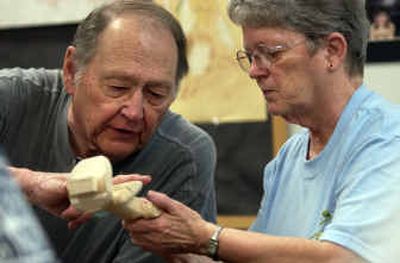Students learn woodcarving from two ‘good teachers’

Gloria Strandquist and Joan Thiele are professional woodcarvers, but don’t call them whittlers. “It aggravates us when people call woodcarvers whittlers,” said Strandquist.
Both retired nurses, Strandquist and Thiele work out of their Valley home’s basement studio, where tables and shelves hold band saws, knives, gougers, Dremels and other hand and power tools. Hundreds of ribbons decorate the walls, all earned in woodcarving competitions.
Intricate birds, fish, animals, caricatures and abstract pieces are included in their gallery.
Every strand of hair on an animal’s coat is cut and burned into the piece to add contrasting colors for a lifelike effect. Their human representations have recognizable expressions created by small carving tools. Strandquist and Thiele use linden or basswood for their creations.
Members of the Spokane Carvers Association, Strandquist and Thiele travel to woodcarving shows to show their work. They have also been teaching the craft for 10 years at Spokane Art Supply, 14401 E. Sprague Ave.
Larry Phipps, one of their students, started woodcarving after he saw a friend carving on a stick. He has won two first-place ribbons in a novice division. “Thanks,” he said, “to two good teachers.”
Tom Ellis, a student of three years, can’t explain it but has always known he was a carver. Now that he is retired, he constantly carves.
Jack Harvey, another student, has been doing Indian-inspired art for many years. “Art captures my soul,” said Harvey, “and carving captured my heart.”
All of Strandquist and Thiele’s students are passionate about carving. Upon entering a class, it might at first glance seem like surgery. They wear magnifying glasses and use sharp tools, but instead of thin latex gloves, theirs are wire mesh. It’s dangerous work, many students say, and bandages and super glue are always nearby for that occasional slip.
Many of the students are retired but their hands are not idle.
Though Strandquist and Thiele are not fond of the term whittler, the word has its place in history books. From inventor Eli Whitney, known as the Yankee Whittling Boy, to the Whistling and Whittling Brigade of 1845, whittling represents more than an old man on his stoop.
Naval officer, inventor and 19th century author Capt. Frederick Marryat dedicated a chapter in his book “Diary in America” to whittling. “Some are so wedded to it from long custom,” he said, “that if they have not a piece of stick to cut, they will whittle the backs of the chairs, or anything within their reach.”
Even a pop culture character out of the “Twin Peaks” television series, Special Agent Dale Cooper (played by Kyle McLachlan), had something to say on the subject: “I’m whittling because that’s what you do in a town where a yellow light still means slow down, not speed up.”